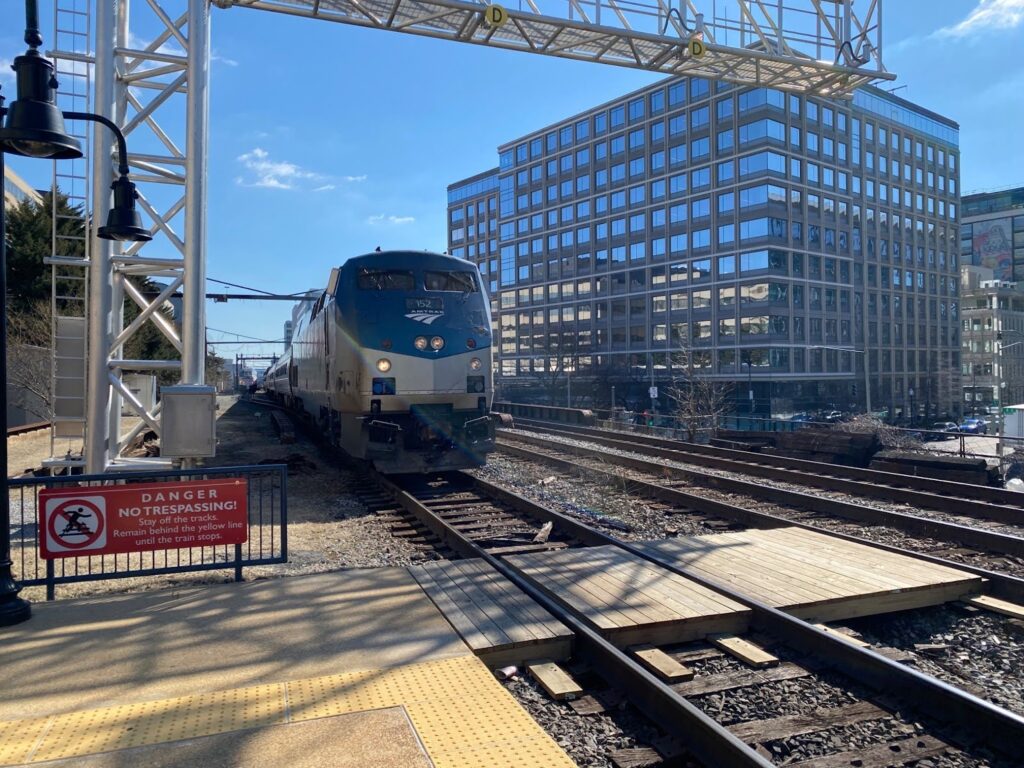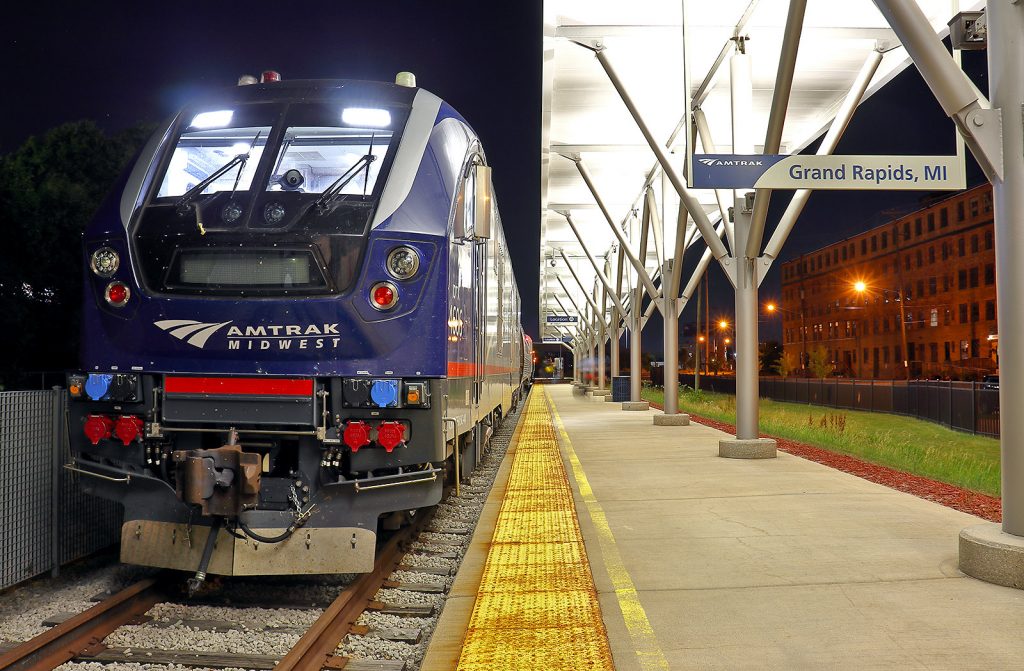
Will Congress hold Amtrak accountable for providing essential passenger rail service?

Communities large and small, urban and rural, are served by Amtrak’s national network of long distance routes, providing essential connections to jobs, services, and the broader economy. Amtrak is threatening to dramatically cut these services, severing essential connections despite clear directives from Congress. Here’s a rundown from a recent hearing on this issue in the House Transportation and Infrastructure’s railroad subcommittee.

An Amtrak train in Grand Rapid, MI, this past July. Photo by Russell Sekeet on Flickr’s Creative Commons.
Amtrak has been hard hit through the pandemic. Ridership has cratered—especially on the Northeast Regional and Acela services—but the railroad has continued to operate nearly all its routes especially as many places have cautiously reopened. Reduced ticket revenues, combined with extra costs for cleaning and protective equipment, have led the company to a point where they are considering cutting many daily long-distance service down to just three-days-a-week in many places and making significant cuts to its workforce.
These massive cuts would have an outsize impact on rural communities and take away valuable lifeline services that often are the only connection between smaller areas and bigger cities, connecting thousands with vital services. Noting that ridership is actually down the least on the long-distance routes, T4America chair John Robert Smith told the Daily Yonder that rural communities consider these services essential, and that “you greatly limit communities served by 7-day a week service when you go to three.” (Read more from the Rail Passengers Association about the impact of these cuts)
Members of Congress from both sides of the aisle have expressed deep concern about these perhaps penny wise but definitely pound-foolish plans. This week the members of the House’s main rail subcommittee held a hearing this week to understand Amtrak’s decisions during the COVID-19 pandemic—and ask some pointed questions.
T4America worked to educate committee staff about the consequences of Amtrak’s planned cuts to long-distance services from daily to three-days per week on most routes. T4A provided resources to committee staff with sample questions and expected responses based on Amtrak’s recent and past assertions.
Opening the hearing, Chairman Dan Lipinski (D-IL) echoed many of the same priorities we share. Lipinski affirmed past lessons from deep cuts made back in 1994, that cutting long-distance trains from daily to three-days per week doesn’t work for passengers or taxpayers, as utility of the service collapses, and subsidies per rider increase. He praised the work of former Senator Trent Lott (R-MS) to restore daily long-distance services, and emphasized Amtrak’s role as a national public service rather than a purely profit-making enterprise.
No member of the committee sided with Amtrak in its position that cutting service and furloughing staff was necessary or prudent. To the contrary, many members, including Republicans and Democrats alike, criticized the railroad for first taking supplemental funding, then planning to still lay off staff and cut services. One of the biggest critiques is that the massive service cuts and layoffs would only save Amtrak a marginal amount of money in the end, especially when the costs are factored in to restore service and train new staff down the road.
Some members took issue with Amtrak’s plans to restore a 7 percent employer 401k match for management employees, that is timed to coincide with the railroad’s service cuts and frontline staff furloughs. Amtrak’s CEO Bill Flynn defended the decision as necessary to retain management personnel, especially at the lower levels, after making cuts earlier in the pandemic. Flynn also went on record saying that executive bonuses and incentive pay would be suspended for three years, but it was not immediately clear when the three-year prohibition began.
When asked about continuing the long-distance services long term, Flynn said Amtrak would run services as directed by Congress, but that he “100 percent supports” the long-distance trains as part of Amtrak’s future. Flynn cited Amtrak’s recent purchase of 75 new locomotives for the long-distance services as proof of this commitment. However, locomotives can be reassigned to other services, and his statement made no mention of allocating specialized equipment for long-distance service like sleeping and dining cars which the railroad has recently taken delivery of but still does not fully utilize.
Rail Passenger Association President and CEO Jim Mathews testified powerfully about the impact of service cuts not only on long-distance riders, but to the hundreds of communities served by Amtrak trains across middle America. “It is not — it is only required to minimize subsidies,” Mathews said. “A conversation about [Amtrak] profit ignores the benefit that communities receive.”
Mathews outlined a study that we helped the RPA produce which estimates losses in visitor spending of over $2.3 billion to station communities and regions if Amtrak’s planned service cuts last for nine months. The study uses a methodology T4A helped develop as part of our longstanding work to restore service to the Gulf Coast, in partnership with the Trent Lott Center at the University of Southern Mississippi.
When it comes to those who are on the frontlines of providing Amtrak’s service, members from two of Amtrak’s unions focused on the sacrifices they and their members have made to maintain service across the Amtrak network, and the public health dangers Amtrak workers are still facing.
Arthur Maratea, National President, Transportation Communications Union (TCU/IAM); and Amy Griffin, President of America Local 1460, Transport Workers Union of America spoke on behalf of Amtral’s frontline workers. They also addressed a shortage of coach cleaners on the railroad, and say Amtrak is not hiring to fill open positions despite the increased need for sanitation, endangering workers and the traveling public.
One of the best perspectives came from an urban Democrat from Massachusetts, who understands that service for people in states far away from his district is what’s at stake, but that a unified national system is vital for everyone. From Trains Magazine:
Near the end of session, Rep. Stephen Lynch (D-Mass.) told Flynn, “I fully support using money you make on the north end of the Northeast Corridor to provide service to some of those rural areas — the ‘red’ states. Those lines don’t necessarily benefit my district but they benefit the country. … I hope you take very seriously the credibility that you will lose by engaging in these furloughs, and the representational damage that comes to Amtrak management. I’m asking you to reconsider that [because] it is not going to save the day.” Cutting 2000 employees, Lynch said, “is going to reduce service and spiral that bottom-line deficit. You’re going to lose the faith of members of Congress like me, who are behind you, because of this decision.”



